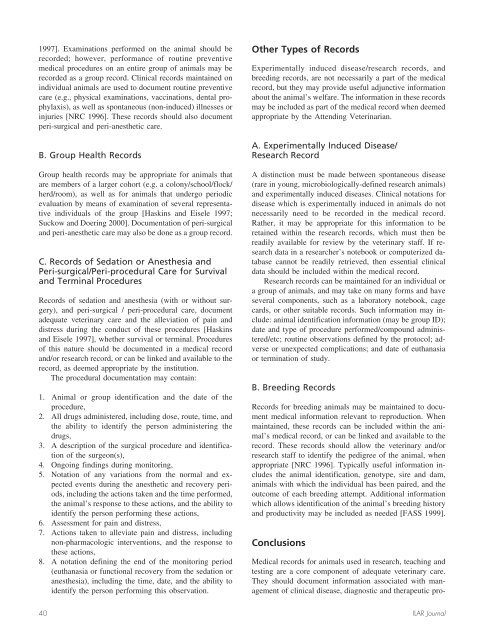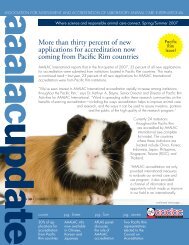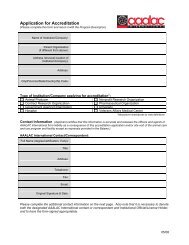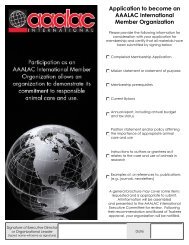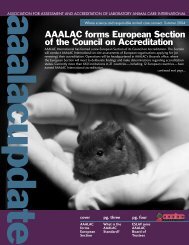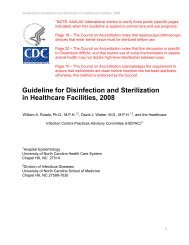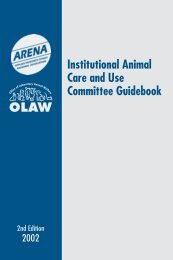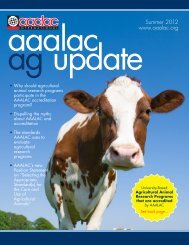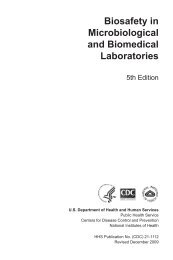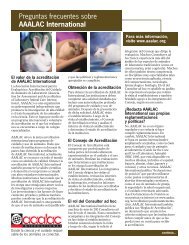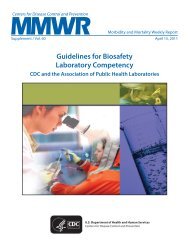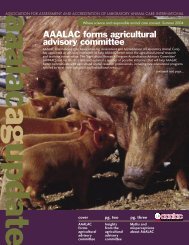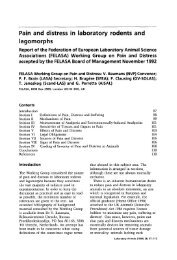Medical Records for Animals Used in Research, Teaching ... - Aaalac
Medical Records for Animals Used in Research, Teaching ... - Aaalac
Medical Records for Animals Used in Research, Teaching ... - Aaalac
You also want an ePaper? Increase the reach of your titles
YUMPU automatically turns print PDFs into web optimized ePapers that Google loves.
1997]. Exam<strong>in</strong>ations per<strong>for</strong>med on the animal should berecorded; however, per<strong>for</strong>mance of rout<strong>in</strong>e preventivemedical procedures on an entire group of animals may berecorded as a group record. Cl<strong>in</strong>ical records ma<strong>in</strong>ta<strong>in</strong>ed on<strong>in</strong>dividual animals are used to document rout<strong>in</strong>e preventivecare (e.g., physical exam<strong>in</strong>ations, vacc<strong>in</strong>ations, dental prophylaxis),as well as spontaneous (non-<strong>in</strong>duced) illnesses or<strong>in</strong>juries [NRC 1996]. These records should also documentperi-surgical and peri-anesthetic care.B. Group Health <strong>Records</strong>Group health records may be appropriate <strong>for</strong> animals thatare members of a larger cohort (e.g. a colony/school/flock/herd/room), as well as <strong>for</strong> animals that undergo periodicevaluation by means of exam<strong>in</strong>ation of several representative<strong>in</strong>dividuals of the group [Hask<strong>in</strong>s and Eisele 1997;Suckow and Doer<strong>in</strong>g 2000]. Documentation of peri-surgicaland peri-anesthetic care may also be done as a group record.C. <strong>Records</strong> of Sedation or Anesthesia andPeri-surgical/Peri-procedural Care <strong>for</strong> Survivaland Term<strong>in</strong>al Procedures<strong>Records</strong> of sedation and anesthesia (with or without surgery),and peri-surgical / peri-procedural care, documentadequate veter<strong>in</strong>ary care and the alleviation of pa<strong>in</strong> anddistress dur<strong>in</strong>g the conduct of these procedures [Hask<strong>in</strong>sand Eisele 1997], whether survival or term<strong>in</strong>al. Proceduresof this nature should be documented <strong>in</strong> a medical recordand/or research record, or can be l<strong>in</strong>ked and available to therecord, as deemed appropriate by the <strong>in</strong>stitution.The procedural documentation may conta<strong>in</strong>:1. Animal or group identification and the date of theprocedure,2. All drugs adm<strong>in</strong>istered, <strong>in</strong>clud<strong>in</strong>g dose, route, time, andthe ability to identify the person adm<strong>in</strong>ister<strong>in</strong>g thedrugs,3. A description of the surgical procedure and identificationof the surgeon(s),4. Ongo<strong>in</strong>g f<strong>in</strong>d<strong>in</strong>gs dur<strong>in</strong>g monitor<strong>in</strong>g,5. Notation of any variations from the normal and expectedevents dur<strong>in</strong>g the anesthetic and recovery periods,<strong>in</strong>clud<strong>in</strong>g the actions taken and the time per<strong>for</strong>med,the animal’s response to these actions, and the ability toidentify the person per<strong>for</strong>m<strong>in</strong>g these actions,6. Assessment <strong>for</strong> pa<strong>in</strong> and distress,7. Actions taken to alleviate pa<strong>in</strong> and distress, <strong>in</strong>clud<strong>in</strong>gnon-pharmacologic <strong>in</strong>terventions, and the response tothese actions,8. A notation def<strong>in</strong><strong>in</strong>g the end of the monitor<strong>in</strong>g period(euthanasia or functional recovery from the sedation oranesthesia), <strong>in</strong>clud<strong>in</strong>g the time, date, and the ability toidentify the person per<strong>for</strong>m<strong>in</strong>g this observation.Other Types of <strong>Records</strong>Experimentally <strong>in</strong>duced disease/research records, andbreed<strong>in</strong>g records, are not necessarily a part of the medicalrecord, but they may provide useful adjunctive <strong>in</strong><strong>for</strong>mationabout the animal’s welfare. The <strong>in</strong><strong>for</strong>mation <strong>in</strong> these recordsmay be <strong>in</strong>cluded as part of the medical record when deemedappropriate by the Attend<strong>in</strong>g Veter<strong>in</strong>arian.A. Experimentally Induced Disease/<strong>Research</strong> RecordA dist<strong>in</strong>ction must be made between spontaneous disease(rare <strong>in</strong> young, microbiologically-def<strong>in</strong>ed research animals)and experimentally <strong>in</strong>duced diseases. Cl<strong>in</strong>ical notations <strong>for</strong>disease which is experimentally <strong>in</strong>duced <strong>in</strong> animals do notnecessarily need to be recorded <strong>in</strong> the medical record.Rather, it may be appropriate <strong>for</strong> this <strong>in</strong><strong>for</strong>mation to bereta<strong>in</strong>ed with<strong>in</strong> the research records, which must then bereadily available <strong>for</strong> review by the veter<strong>in</strong>ary staff. If researchdata <strong>in</strong> a researcher’s notebook or computerized databasecannot be readily retrieved, then essential cl<strong>in</strong>icaldata should be <strong>in</strong>cluded with<strong>in</strong> the medical record.<strong>Research</strong> records can be ma<strong>in</strong>ta<strong>in</strong>ed <strong>for</strong> an <strong>in</strong>dividual ora group of animals, and may take on many <strong>for</strong>ms and haveseveral components, such as a laboratory notebook, cagecards, or other suitable records. Such <strong>in</strong><strong>for</strong>mation may <strong>in</strong>clude:animal identification <strong>in</strong><strong>for</strong>mation (may be group ID);date and type of procedure per<strong>for</strong>med/compound adm<strong>in</strong>istered/etc;rout<strong>in</strong>e observations def<strong>in</strong>ed by the protocol; adverseor unexpected complications; and date of euthanasiaor term<strong>in</strong>ation of study.B. Breed<strong>in</strong>g <strong>Records</strong><strong>Records</strong> <strong>for</strong> breed<strong>in</strong>g animals may be ma<strong>in</strong>ta<strong>in</strong>ed to documentmedical <strong>in</strong><strong>for</strong>mation relevant to reproduction. Whenma<strong>in</strong>ta<strong>in</strong>ed, these records can be <strong>in</strong>cluded with<strong>in</strong> the animal’smedical record, or can be l<strong>in</strong>ked and available to therecord. These records should allow the veter<strong>in</strong>ary and/orresearch staff to identify the pedigree of the animal, whenappropriate [NRC 1996]. Typically useful <strong>in</strong><strong>for</strong>mation <strong>in</strong>cludesthe animal identification, genotype, sire and dam,animals with which the <strong>in</strong>dividual has been paired, and theoutcome of each breed<strong>in</strong>g attempt. Additional <strong>in</strong><strong>for</strong>mationwhich allows identification of the animal’s breed<strong>in</strong>g historyand productivity may be <strong>in</strong>cluded as needed [FASS 1999].Conclusions<strong>Medical</strong> records <strong>for</strong> animals used <strong>in</strong> research, teach<strong>in</strong>g andtest<strong>in</strong>g are a core component of adequate veter<strong>in</strong>ary care.They should document <strong>in</strong><strong>for</strong>mation associated with managementof cl<strong>in</strong>ical disease, diagnostic and therapeutic pro-40 ILAR Journal


